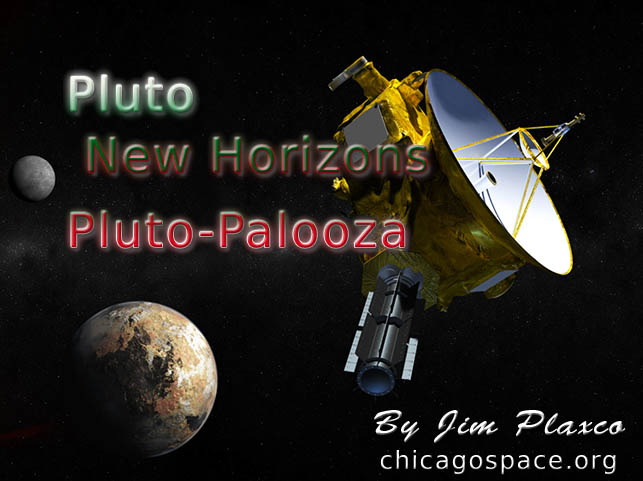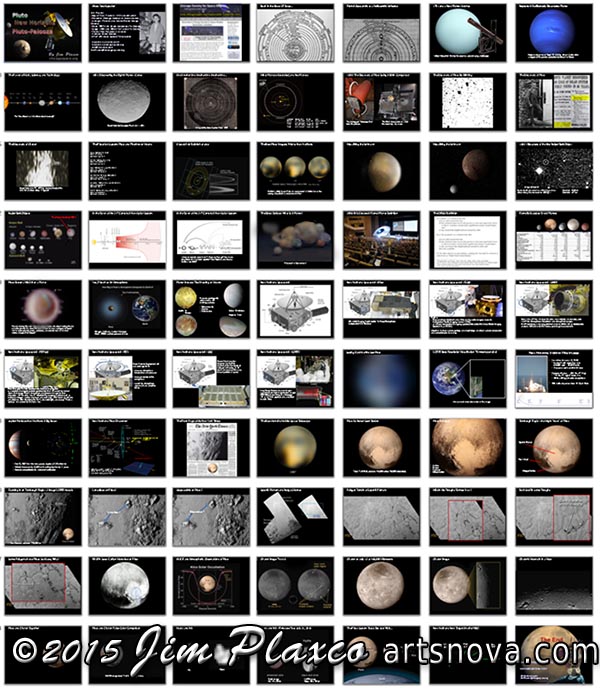Pluto and the NASA New Horizons Mission

Pluto New Horizons Pluto-Palooza talk
One thing consuming my time recently has been the NASA New Horizons mission to Pluto and the spacecraft's passage through the Plutonian system on Tuesday July 14. This mission reawakened a somewhat dormant interest in planetary science. Once upon a time the majority of the talks I gave at area libraries and at science fiction conventions dealt with planetary science, particularly Mars. Over the years as passions waxed and wanned my areas of focus (as least as far as public speaking was concerned) shifted to talks about algorithmic art, astronomical art, generative art, social media, space commercialization, space development, and more recently the Processing programming language.
New Horizons is a historic mission. We've had robotic missions to planets, moons, comets, and asteroids. We've even had the first mission to a dwarf planet – that being the Dawn mission to Ceres. One thing we've never had is a mission to a Kuiper Belt Object (KBO) because that is what Pluto is properly categorized as. In fact, this is one point that I emphasize with my audience – the real value of the New Horizons mission to Pluto is not about visiting the one unvisited planet but about being the first mission to this relatively new category of solar system object. The opportunity to study these ancient icy dwarfs of the solar system close-up is and will continue to be exceedingly rare.
One thing that I have found somewhat annoying has been a number of comments on social media expressing disappointment at the quality of images returned to Earth by New Horizons and that there are so few of them. It's unfortunate that so many people do not understand that the New Horizons spacecraft, by design, can not simultaneously collect data and send data back to Earth. During the close encounter phase (approach, encounter, and departure phases) the spacecraft's job has been to collect data – and rightly so. In the days after the closest approach to Pluto, the images that were being released were all taken from the day before the close encounter when the spacecraft was still over half a million kilometers from Pluto! Recall that on the 14th New Horizons actually flew past Pluto as a distance of a mere 12,500 kilometers. For reference, the geostationary satellites in orbit above the Earth are just shy of 36,000 kilometers over our heads.
I gave my Pluto – New Horizons presentation for the first time on Sunday July 19 at the Schaumburg Library for the meeting of the Chicago Society for Space Studies. I was slightly out of sorts because the laptop I use for my presentations… well that morning when I turned it on I couldn't get past the BIOS startup screen. Fortunately I had made a backup of my presentation on a thumb drive. I hadn't added much after making that copy so the presentation was essentially complete. I pulled out my son's 4+ year old discarded laptop (too many blue screens of death according to him) and used that to do my presentation. (Yes I actually compartmentalize my computing life so that different computers are used for specific functions. And no, I have not yet begun to troubleshoot what's wrong with my "presentations " computer.)
As a consequence of questions from the audience and to tighten up the story line, I deleted a number of slides from the talk while adding a few new ones. Tightening up also helped me to cut the length of my talk because as a speaker I encourage the audience to ask questions as my presentation progresses. I gave this new version of the talk at the Roden Branch of the Chicago Public Library last night. The changes I made both improved the flow and allowed me to finish right on time – even with questions from the audience. Not giving much away, the graphic below shows the 70 slides in the Pluto New Horizons talk that I gave last night.

Slides for my Pluto New Horizons Pluto-Palooza lecture
The next presentation I'll be giving will be at Musecon, a convention for artists, musicians, inventors, gadgeteers, makers, tinkerers, and other creative folks. My talk isn't about Pluto though. What I'll be doing is teaching a class on creating digital spirographs and harmonographs using the Processing programming language.

Creating Digital Spirographs and Harmonographs With Processing presentation
Musecon is August 7,8.9 and is being held at Westin Chicago Northwest in Itasca, Illinois. Musecon's Guest of Honor is Brother Guy Consolmango, President of the Vatican Observatory Foundation and accomplished author. It's been my honor to have been on a few panels with Brother Guy in the past. As I recall, one dealt with asteroids, another with Mars, and the third with planetary science missions in general. These panels were all at science fiction conventions. That's right, there is much more to science fiction conventions than just science fiction.
| Return to the Blog Index | This entry was posted on Wednesday, July 22nd, 2015 at 7:32 pm and is filed under Presentations, Processing.